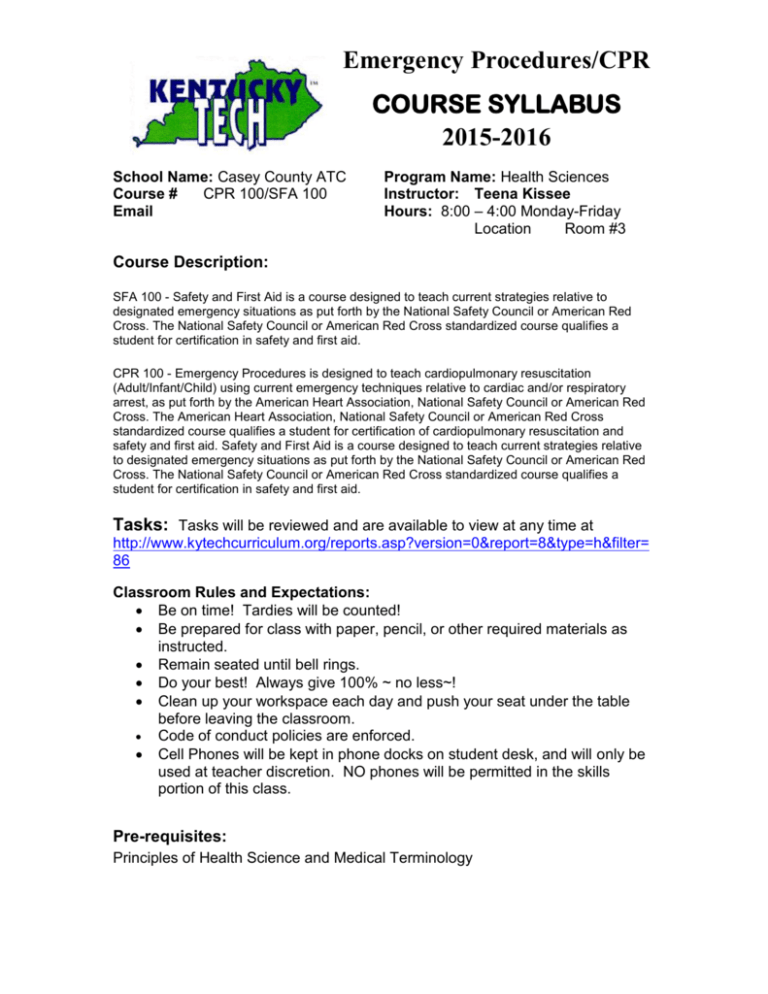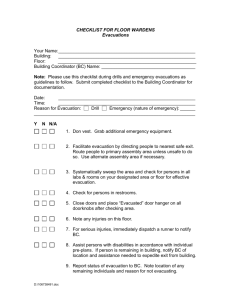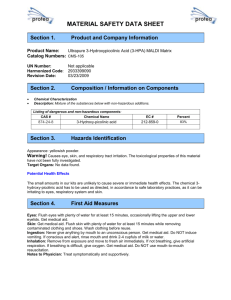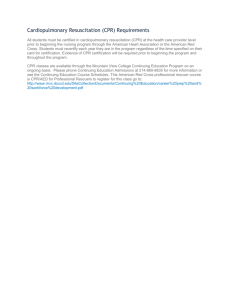Emergency Procedures - Casey County School District
advertisement

Emergency Procedures/CPR COURSE SYLLABUS 2015-2016 School Name: Casey County ATC Course # CPR 100/SFA 100 Email Program Name: Health Sciences Instructor: Teena Kissee Hours: 8:00 – 4:00 Monday-Friday Location Room #3 Course Description: SFA 100 - Safety and First Aid is a course designed to teach current strategies relative to designated emergency situations as put forth by the National Safety Council or American Red Cross. The National Safety Council or American Red Cross standardized course qualifies a student for certification in safety and first aid. CPR 100 - Emergency Procedures is designed to teach cardiopulmonary resuscitation (Adult/Infant/Child) using current emergency techniques relative to cardiac and/or respiratory arrest, as put forth by the American Heart Association, National Safety Council or American Red Cross. The American Heart Association, National Safety Council or American Red Cross standardized course qualifies a student for certification of cardiopulmonary resuscitation and safety and first aid. Safety and First Aid is a course designed to teach current strategies relative to designated emergency situations as put forth by the National Safety Council or American Red Cross. The National Safety Council or American Red Cross standardized course qualifies a student for certification in safety and first aid. Tasks: Tasks will be reviewed and are available to view at any time at http://www.kytechcurriculum.org/reports.asp?version=0&report=8&type=h&filter= 86 Classroom Rules and Expectations: Be on time! Tardies will be counted! Be prepared for class with paper, pencil, or other required materials as instructed. Remain seated until bell rings. Do your best! Always give 100% ~ no less~! Clean up your workspace each day and push your seat under the table before leaving the classroom. Code of conduct policies are enforced. Cell Phones will be kept in phone docks on student desk, and will only be used at teacher discretion. NO phones will be permitted in the skills portion of this class. Pre-requisites: Principles of Health Science and Medical Terminology Materials Used: Textbooks: National Safety Council: First Aid with CPR & AED/ FirstAid & CPR Participant’s Book, American Red Cross. Tools: Powerpoints Supplies: Choking Manikin, AED Simulator, Resuscitation Manikins Student Organizations: Students enrolled in any Health Science class at the ATC may join the Health Occupations Students of America (HOSA). Dues are $25.00. This covers state and local dues. T-shirt cost(s) are not included in dues amount. Course Requirements: 1 2. 3. Successfully complete all written assignments/tests successfully. Complete all lab projects Abide by all Lab Safety Rules Tests, Quizzes, In-class Assignments Demonstration of mastery of content will be in the form of performance and/or written assessments, assignments, and activities. Ample time will be given in class to finish most tasks. Some homework may be required. If necessary, students may stay after school Monday – Friday until 4:00 pm when scheduled in advance. Fees: Lost/damaged books will require reimbursement in the amount of the cost of a new book prior to graduation. In addition if students wish to purchase a card additional fees apply. For example, American Red Cross is $26.00. Fees are subject to change. Field trips may require a fee for transportation and registration. Cost of CPR (Heartsaver) Certification. $27.00 per card. In addition this is only an estimate and cost vary per year. GRADING Procedures: 1. 2. 3. Daily Performance Tests Grade Assignment: 90 – 100 80 – 89 70 – 79 60 – 69 0 - 59 A B C D F 20% 40% 40% Health Science Classroom Safety Rules Walk – Do NOT Run! Keep Aisles clear. All chair legs must remain in contact with the floor at all times. Absolutely NO horseplay! No food or drinks allowed in the classroom. Report any hazardous situations immediately! Only one person may be absent from the classroom at any given time. Classroom Expectations Safety orientation will be conducted during the first 2-3 weeks of school. This includes completing a unit on common safety issues in the classroom laboratory and health care setting; instruction regarding earthquake, fire, tornado, and bomb threat evacuation procedures; location of fire extinguishers, primary/secondary exits; and the location and use of Safety Data Sheets. Students must take AND pass a safety test. Safety Inspections A safety committee of student members will be appointed. A safety inspection of the health science classroom will be completed each month. The inspection checklist and safety form will be signed by each student member, the teacher, and the principal. These inspections are in addition to the semi-annual school inspections. Evacuation Procedures The following procedures will be followed: School evacuation plan will be posted in the classroom where easily viewed by all students. Students will be instructed in the proper evacuation procedures during safety orientation. Primary and secondary exits will be identified. Students will routinely practice proper evacuation procedures. An outside meeting area will be identified and will be communicated to students during orientation. Hazardous Communication Training Hazardous Communications will be covered during safety orientation. Students will be trained in the proper use of and location of Material Safety Data Sheets. Accidents All accidents should be reported immediately to supervisor/teacher as soon as possible after the accident occurs. An accident report should be completed and filed in the office. I have completed the Safety Orientation for the __Health Sciences__________ program, and certify that I understand all the safety regulations pertaining to it. This orientation included the physical and chemical dangers (cleaners, paints, thinners, solvents, etc. . .) to which I may be exposed while in this shop/classroom as required by the Hazardous Communication Standard; power tool and equipment safety; and general classroom/shop safety. I also understand that I am now under a DIRECT ORDER not to use ANY tools and/or chemicals until and unless the instructor has given permission. I have also been told that to use such tools and/or chemicals without permission will result in disciplinary action. I have received training in the following: ( ) The location of the Hazardous Chemical list and SDS sheets in my classroom/shop area. ( ) How to find and use the corresponding SDS sheets from the hazardous chemical list as part of my safety orientation or in the event of an accident. ( ) I have been instructed on the safe and proper use of the items found on the chemical list in my shop/area classroom. ( ) I know the location of, and have instruction in the safe use of the required personal protective equipment (PPE) for the items listed on the chemical list as well as any tools/equipment. ( ) I have informed my parents about the hazardous communication program, and informed them that the program is available for their scrutiny upon appointment. ( ) I have been shown the location of all fire extinguishers in or near the shop and shown how to use each type. ( ) I have informed my parents about the hazardous communication program, and informed them that the program is available for their scrutiny upon appointment. ( ) I have been shown the location of all fire extinguishers in or near the shop and shown how to use each type. Parent Signature Date Student Signature Date









